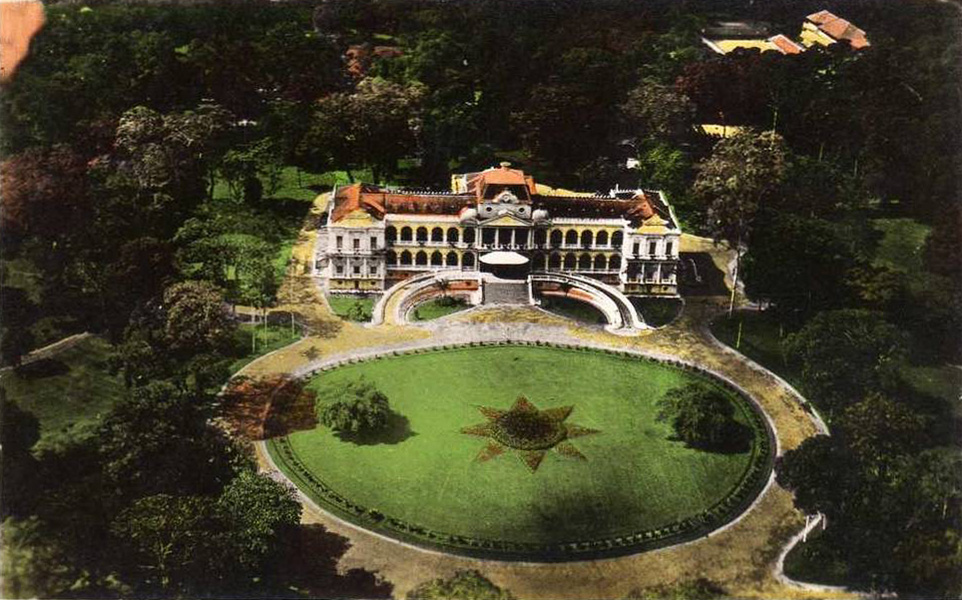
An aerial view of the palais du Gouvernement-général, later known as the Norodom Palace
This article was published previously in Saigoneer http://saigoneer.com
Though now nearly half a century old, the current Unification Palace was conceived as a modern replacement for the Norodom Palace, a much grander French building which had stood on the same site before it for over 90 years.
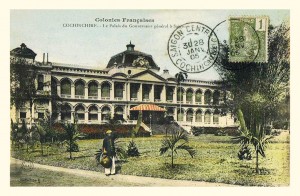
Another view of the palais du Gouvernement-général
After occupying the six southernmost provinces of Việt Nam, the French grouped them together on 25 June 1867 as Cochinchina, to be ruled henceforward as a colony. Then on 23 February 1868, Admiral-Governor Pierre-Paul de la Grandière solemnly laid the first stone as work began on an imposing new colonial government headquarters in Saigon.
The new “palais du Gouvernement-général” was built in neo-Baroque style to plans by Parisian architect Achille-Antoine Hermitte (1840-?), designer of the Sacred Heart Cathedral in Guangzhou (1866) and the first Hong Kong City Hall (1869). It’s said that Hermitte wanted to create a monument which would “honour the finest cities in the world,” and indeed, his grand palace is said to have gobbled up in excess of four million Francs, more than a quarter of the colony’s public works budget.
Admiral-Governor Dupré took up residence in the building in 1873, although the decorative work was not complete until 1875.
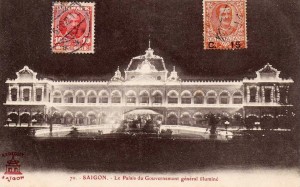
The palace illuminated in the early 20th century
According to an 1885 description: “The palace has a façade not less than 80 metres in length, with two pavilions at either end and a central dome, access ramp and covered stairway. The ground floor, raised above a basement and containing kitchens and ancillary rooms, contains: on the right, offices, the cabinet of the Governor; on the left, the council chamber, the dining room, the telegraph room and the secretariat of the Privy Council; and in the middle, a magnificent hall with a double marble staircase by which one ascends to the first floor rooms. At the end of the hall is the richly decorated ceremonial room, which backs perpendicularly onto the rear façade of the palace and may easily accommodate 800 guests.”
Yet while no expense was spared constructing the palace,subsequent events would conspire to make it virtually redundant, a mere 14 years after its inauguration.
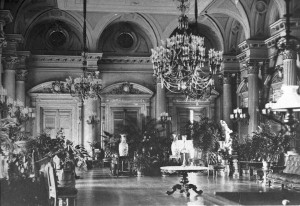
The salle des fêtes (events hall) of the Palais du Gouvernement
In October 1887, Cochinchina was united with Annam, Tonkin and Cambodia to form the Indo-Chinese Union, under a Governor-General based in Hà Nội. The Governors of Cochinchina were downgraded into Lieutenant Governors and, according to the prevailing logic, Lieutenant Governors were not senior enough to reside in what one commentator described as a “princely residence, sumptuously set amidst extensive gardens.” A trade exhibition hall then under construction nearby was hastily repurposed, at considerable cost, to serve as a Lieutenant-Governor’s Palace [the building which now houses the Hồ Chí Minh City Museum] and opened in 1890.
Consequently, for the remainder of the colonial period, the “palais du Gouvernement-général,” known from the early 20th century as the Norodom Palace, was used only as a ceremonial venue and office for the Governors General on the occasions when they visited the south.
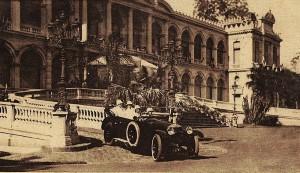
The Governor General and his guest Marshal Joffre leaving the palace by car in December 1921
In his Indo-Chine française (souvenirs) of 1905, Governor-General Paul Doumer commented: “When we arrived there in 1897, the palace felt like it was abandoned, since it had been left for 10 years. This was because the Governor General, always based in Tonkin which he administered, no longer lived in Cochinchina other than by exception, in passing and for just a few days.”
To make matters worse, the land on which the palace stood had not been surveyed properly before construction began, and ongoing subsidence necessitated frequent and costly remedial work. In 1893 the central dome had to be replaced.
By the 1920s the vast sums spent on the palace and its apparent pointlessness had become a matter of public debate. The 7 November 1926 edition of the newspaper L’Eveil économique de l’Indochine even went as far as commenting cheekily: “What a magificent hotel the Governor General’s Palace in Saigon would make!”
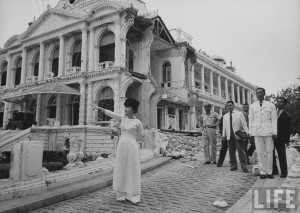
Madame Nhu surveys the damage with the press in tow following the bombing of 27 February 1962
On 7 September 1954, High Commissioner General Paul Ély, so-called “liquidator” of French Indochina, handed over the Norodom Palace to the new South Vietnamese administration. Its name was changed to Independence Palace (Dinh Ðộc lập) and in subsequent years, it belatedly found a useful role to play as Ngô Ðình Diệm’s presidential palace. However, this new role would not last.
On 27 February 1962, a coup faction in the South Vietnamese armed forces sent fighter pilots Nguyễn Văn Cử and Phạm Phú Quốc in two AD6 aircraft to drop bombs on the Norodom Palace, demolishing the entire left wing of the building. Instead of reconstructing it, Diệm ordered the demolition of the whole building and the construction of a new palace – the current one – in its place.
Today, just one fragment of the original Norodom Palace survives. The southeast gatehouse on Nguyễn Du street, which famously bore the brunt of the Tết 1968 attack on the presidential palace, is believed to date from the early 20th century.
Tim Doling is the author of the guidebook Exploring Saigon-Chợ Lớn – Vanishing heritage of Hồ Chí Minh City (Nhà Xuất Bản Thế Giới, Hà Nội, 2019)
A full index of all Tim’s blog articles since November 2013 is now available here.
Join the Facebook group pages Saigon-Chợ Lớn Then & Now to see historic photographs juxtaposed with new ones taken in the same locations, and Đài Quan sát Di sản Sài Gòn – Saigon Heritage Observatory for up-to-date information on conservation issues in Saigon and Chợ Lớn.

